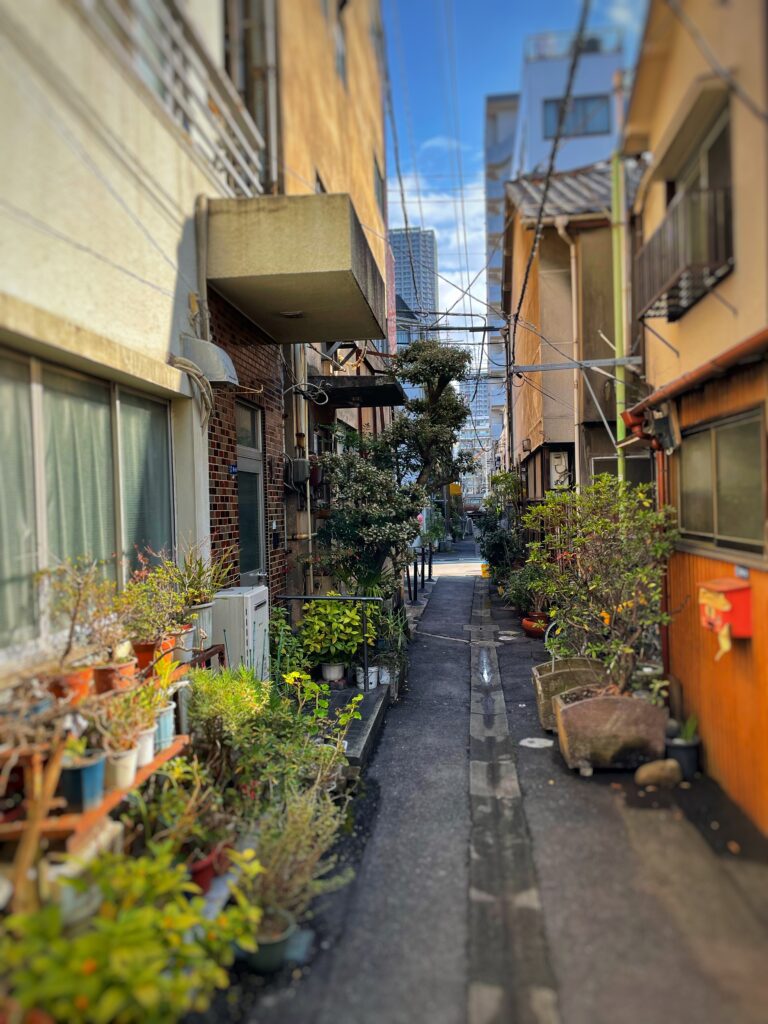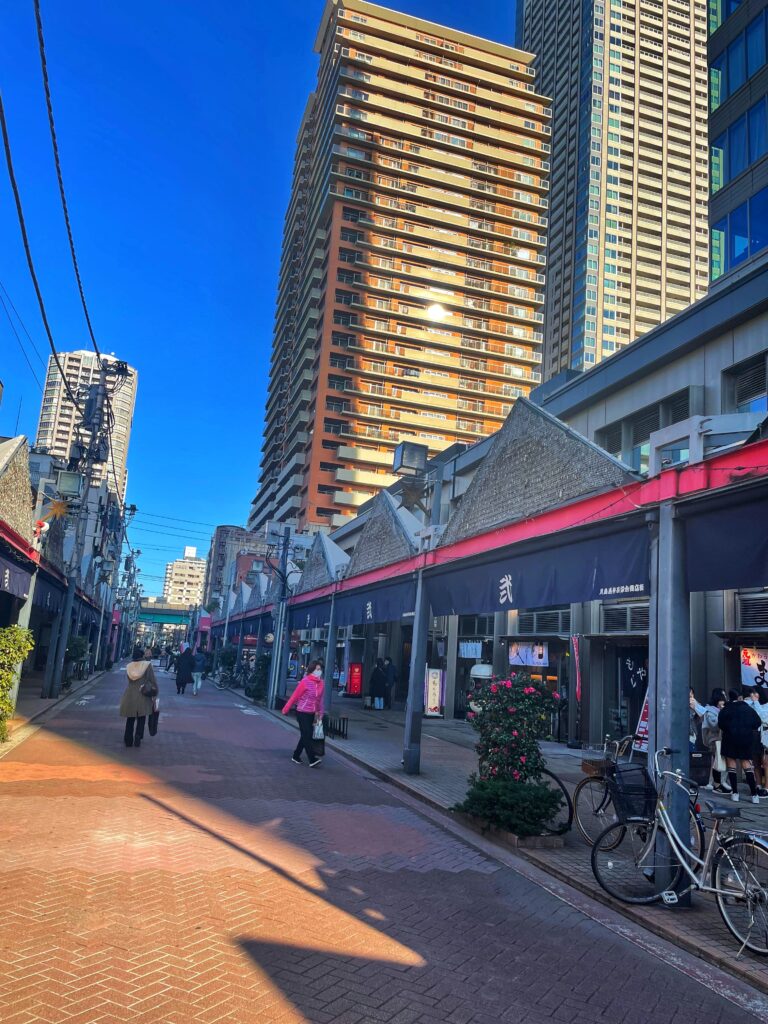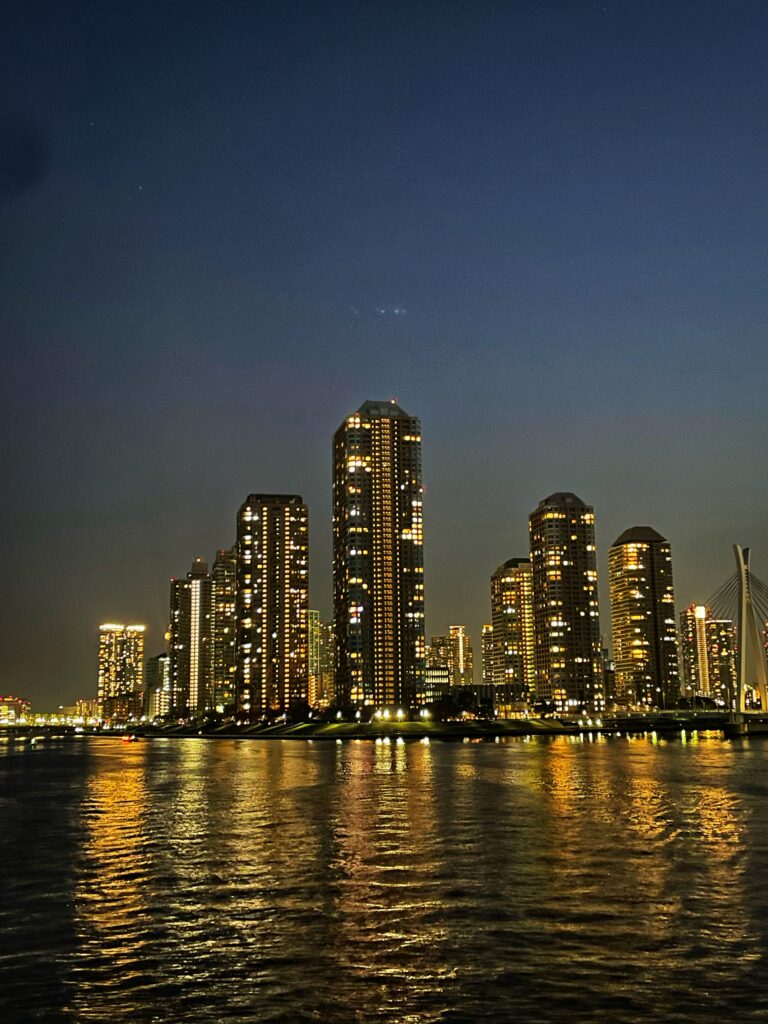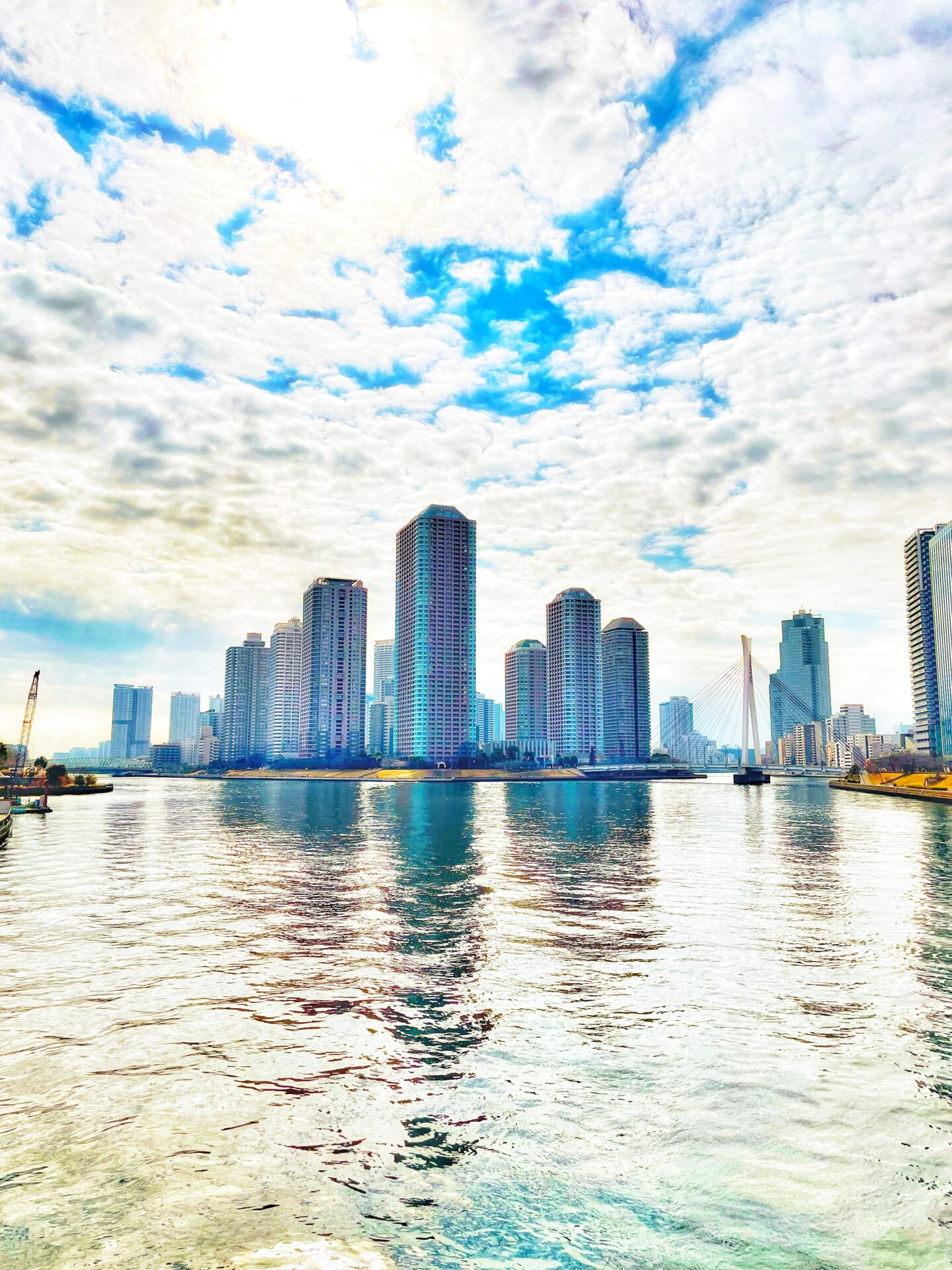Housing for workers
If one then leaves this remnant of Edo’s deep past and heads south back down the island, one will enter an area still marked by the times when the bay was heavily industrialized — those early stages of Tokyo renouncing water as part of its soul.
At the turn of the last century, the district of Tsukushima was added to the original settlement of Tskudajima using sediment dredged from the river’s increasingly clogged mouth.
(The character “tsuki” in the name Tsukishima, before becoming “月,” or “moon,” was initially “築”, meaning to fabricate, build or construct, a reference to its reclaimed nature, like the name of the earlier-reclaimed Tsukiji (築地) district on the west bank of the Sumida where Tokyo’s famous fish market was once located.)
The construction of Tsukishima was, in fact, the first in a series of major extensions of Tokyo into its bay that took place at the time, with the districts of Shibaura and Tennozu in Shinagawa Ward, and Harumi, Toyosu and Shinonome in Koto Ward, also added in the next few decades.
Part of the reason was to find sites for industry, but another aim was to find new housing space for people moving into the burgeoning city — a goal that is worth keeping in mind when it comes to the most recent developments in the bay.
Tsukishima, then, was once the site of factories and warehouses, with a working-class population living in small houses jammed together on either side of narrow passageways. In fact, while it is now dotted with high-rise condominiums, it still retains much of this old housing around the feet of these new giants, giving the area much of its charm.

Any visitor to Tsukishima, for instance, is likely to make for the arcade running down its spine lined with restaurants serving the Tokyo specialty of monjayaki, a type of runny pancake, but look down the narrow gaps between the blocks and you’ll still see these little passageways, too narrow for any vehicles, and their small houses, little changed in appearance from half a century ago or more.
Now, some of the houses have been turned into cozy bars, cafes and eateries, or even the studios of professionals such as architects, but a lot of the houses are still lived in by elderly residents whose families have been in the area for generations.
One can still find these pockets of old housing in downtown areas, too — former low-city neighbourhoods west of the Sumida that are now mainly business districts. But they are few and far between in those areas. Here in Tsukishima, they abound.
Monjayaki pancakes
With such a history, it’s not surprising, then, that Tsukishima is one of the best-known places to find these monjayaki pancakes, the city’s own “working-class food.”
But in fact, rather like tsukudani, what is served today has evolved considerably from its first roots. How it has done so tracks the way Tsukishima itself has evolved from being a working-class district to an area with a large white-collar population (the numbers residing in the big, new apartment blocks dwarf those still living in the little houses around the narrow passageways) with, before the pandemic anyway, a stream of gastronomically curious tourists thrown in as well.

Monjayaki is closely related to but a runnier version of the better-known okonomiyaki that originated in Kansai. It is said to have started life in a botched attempt by one of those old dagashiya sweet shops in low-city Tokyo in the early 20th century to make a kids’ version of the popular Kansai food, but with too much stock used.
As such, it became a cross between a snack and a game for kids, who would sit on either side of mini-hotplates that were once ubiquitous in dagashiya and drip batter made from udon flour to make characters with it — hence the name, whose first two syllables recall the word for “letter” (monji). It wasn’t hard to imagine kids doing just that once upon a time in that dagashiya just up the road in Tsukudajima.
These hotplates could still be found in dagashiya until the 1970s, but in the meantime, starting in around the 1950s, monjayaki crossed over into being a food for adults, too — without the letter-forming, of course, but with the gradual addition of some of what became the signature traditional ingredients, including cabbage, bits of squid, and tiny dried cherry shrimps.

But a bit like the Western pizza, there’s no limit to the ingredients one can add to monjayaki. As a result, it becomes a kind of barometer of its age.
Once a rough-and-ready, and inexpensive, working-class food bought at stalls with bits of seafood from the bay and some shaved cabbage, now it’s something that might include cheese, cream, or Italian ham. And those diners in those restaurants in the arcade won’t find it cheap, either. Like Tsukishima the area, monjayaki has left its origins far behind.
Where the future began
As one heads to the area called Kachidoki and on to Toyomicho, the old low-city or working-class soul of the area gradually diminishes; the further south one gets, the more one leaves the monjayaki restaurants and the pockets of old housing behind. Instead, the scene is dominated now by the huge apartment complexes, some with over 50 stories whose top floors seem utterly removed from the streets below.
The atmosphere begins to become monotonously and aridly geometrical, with endless rows of repeating windows on endless floors, one block of it following another. One is leaving Tokyo’s past behind and entering its future — or at least the future as planners and big construction firms would have it.
But there is no reason to linger here. In fact, there is nothing to savour — all the savouring is done up in the towers, the higher the better for that panoramic view of the city that their developers advertise.
Instead, to complete the journey of understanding, one has to double back and end up at the northern tip of the “island,” in what was once Ishikawajima, one of the original two sandbars, on which, while fishermen moved into Tskudajima, a shogunal retainer called Ishikawa built a mansion (hence the name — literally “Ishikawa island”). It was here, on this piece of land reclaimed created right at the birth of Edo, that this vision of Tokyo’s future was first developed.
Some people may already feel familiar with the name Ishikawajima. It features in the name of what is now the Ishikawajima-Harima Heavy Industries Co., Ltd. conglomerate. In the last years of the shogunate, the grounds of the riverside mansion, now vacated, became a shipyard operated by one of the feudal domains allied to the Tokugawa.
After the fall of the shogunate, the shipyard was sold to the private sector and gave birth to what became at first Ishikawajima Heavy Industries. The shipbuilding facilities did not move out until 1979. What they left was a huge site for redevelopment.
At the time, Tokyo’s planners were seeking to revitalize areas of the waterfront, particularly where industry had moved out. One of their chief aims was to allow large populations to live there — a laudable goal, since it would let the new residents avoid the punishing commutes they might otherwise have faced.

Battery Park City in New York and Docklands in London were used as reference points. And by the early 1990s, eight huge towers, Tokyo’s very first super high-rise residential complexes, had arisen.
The land taken from the water, in other words, having already been used to house an influx of people, was now going to help Tokyo maintain its huge size and prevent it from becoming unmanageable. Instead of spreading further outwards, it could start expanding vertically.
To give them their due, the arrangement of these towers at the tip of this man-made island in the Sumida can give them, when viewed from a boat on the river, or a nearby bridge, and particularly at night, a kind of gravitas or monumentality that other similar developments lack.
It is almost as if they stand there like sentinels, guarding something — and that something is, of course, a gate into Tokyo’s future. Since they appeared, super-high-rise apartment complexes have reared up all over the bay’s reclaimed islands and in many downtown areas too. There is nothing special about them now at all — they’re too ubiquitous.
But even so, the emergence of each new one, often paired with office towers and shops and restaurants, always feels like a loss. A dense area of particularity, of small lanes, hints of a deep past, remnants of an old community, get swept away and replaced by squares and rectangles and brands and chains.
The “island” of Tsudajima-Tsukishima-Kachidoki-Toyomicho feels like it throws this process into sharp relief because of the amount of that deep past that still, thankfully, remains in the shadows of the new towers. But it’s hard not to wonder how much of the old housing will still be left in a few decades’ time.
Kachidoki Bridge, a nice old coat-hangar-like structure dating from the 1940s that joins this man-made island to the west bank of the Sumida, featured in the very first of the Godzilla movies in 1954 (called, simply enough, “Godzilla”).
The monster flips the bridge over during its rampage through the city. One can’t help feeling in a way that Tokyo’s future self is a kind of Godzilla, born on what used to be a sandbar in the Sumida, and now, unleashed into the city, doing its steady work of destruction.
End
